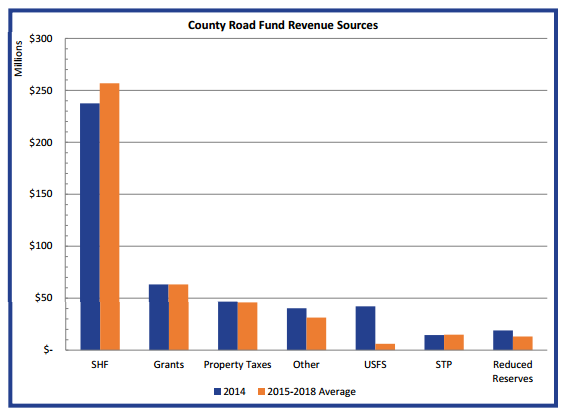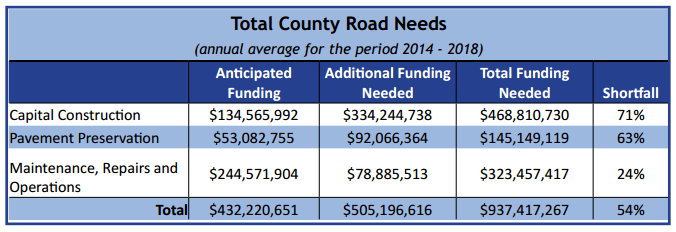ASSOCIATION OF OREGON COUNTIES
Executive Summary
The statewide revenue forecast over the next five years shows a 54 percent annual shortfall for county road departments. This translates into the need for an additional $505 million per year for counties based on revenue forecasts.
The County Road System
County roads are a critical component of Oregon’s integrated road system. Oregon’s road system totals approximately 68,141 miles. Counties are responsible for the largest share of Oregon’s road system, with 26,670 miles under county jurisdiction (39 percent). The county road system also includes 3,421 bridges and approximately 26,000 culverts.
Objectives
The objective of the County Road Needs Study is to determine and demonstrate the funding needed to maintain and manage the county road system to meet the needs of the traveling public over the next five years (2014-2018).
This study describes:
- Anticipated funding for county roads;
- The impact forecasted revenues will have on service delivery over the next five years;
- How federal funding priorities will influence county projects;
- Which activities are a priority for counties along with the needed additional funding; and
- How the different regions of the state are facing changes in revenues and services.
Methods
Each county was provided with forecasted revenues from the U.S. Forest Service (USFS), the Federal Highway Administration’s (FHWA) Surface Transportation Program (STP) and the State Highway Fund
(SHF) allocations to counties from 2014-2018. Each of the 36 county road departments was asked to estimate locally generated funds for their county.
Each county identified the projects and services they anticipate will be provided in the upcoming five calendar years (2014-2018). Counties were then asked to consider the condition of their road system and report what projects and activities need to be done and how much those projects/activities would cost.
Expenditures
County road departments categorized expenditures by:
- Capital construction which includes bridge construction, road reconstruction, safety projects, intersections, and bicycle/pedestrian projects;
- Pavement preservation which includes chip seals and pavement overlays; and
- Maintenance, repairs and operations which includes roadway drainage, shoulder maintenance, bridge maintenance, vegetation management, and storm response and repairs.
Funding
Almost all of the funding budgeted for county roads is earmarked for road purposes only. The funding sources are USFS revenue, Federal-Aid, Oregon’s SHF and locally generated revenue. Currently, the majority of revenue comes from the SHF. For over 100 years, many counties have relied on forest revenue to fund their roads. These payments have significantly declined to approximately 42 percent of what was received in the early 1990’s. The last payment was received in 2014. However, unless there is a future extension of the Secure Rural Schools and Community Self Determination Act, federal forest revenues to counties are anticipated to drop to less than 4 percent of early 1990’s level. This study does not assume a reauthorization and therefore, no Secure Rural Schools payment after 2014.
Conclusion
Road departments are making the maintenance and preservation of roads the top priority, because it is far more economical to maintain what you have than it is to let the roads deteriorate, and have to pay for a rebuild. Anticipated revenue will not even meet the need for maintenance. Pavement preservation, such as overlays, and capital construction projects, such as road rebuilds and bridge reconstruction, have been on hold. Over the next five years, counties anticipate a 63 percent shortfall for pavement preservation projects and a 71 percent shortfall for capital construction.
Counties are facing an additional need for $505 million per year to keep up with the needs of the traveling public. If a gas tax increase (and commensurate increase in weight-mile tax) were to meet the need, the state would need to increase the gas tax by an estimated $0.64 per gallon (for every cent increase in the gas tax, counties estimate receiving about $7.9 million). To meet the county needs for only capital construction projects, the gas tax would need to be increased by $0.42. To only meet the need for pavement preservation and maintenance, repairs and operations, counties would need an estimated $0.22 increase per gallon. Counties understand these increases are unlikely in the current fiscal climate, but the numbers demonstrate the overwhelming funding shortfall.
Download full version (PDF): County Road Needs Study
About the Association of Oregon Counties
www.aocweb.org
For more than a century the Association of Oregon Counties has been dedicated to improving the ability of county government to serve Oregonians. AOC was organized in 1906 to provide a forum for information sharing and consensus development among Oregon counties.
Tags: AOC, Association of Oregon Counties, OR, Oregon








 RSS Feed
RSS Feed